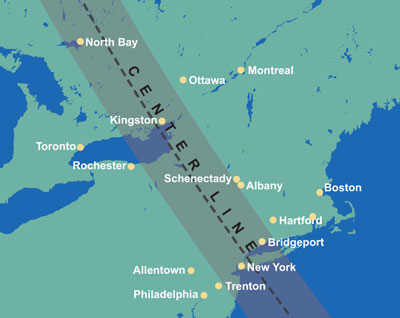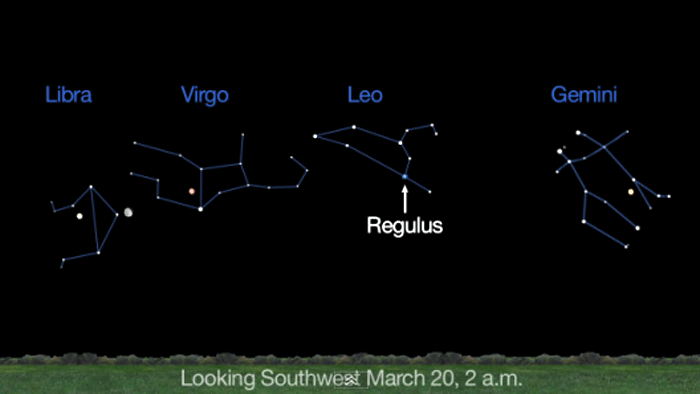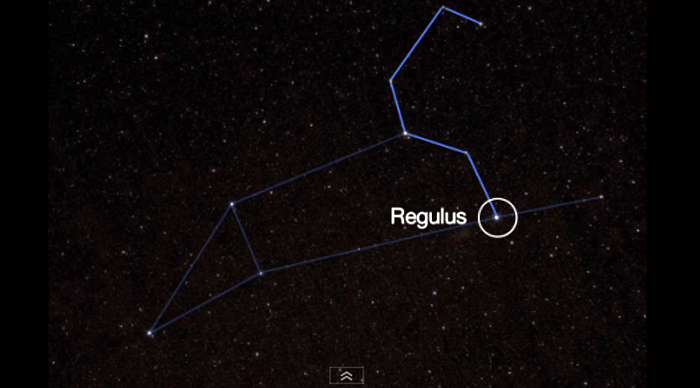.
Look out for the best asteroid occultation ever from North America as the bright naked eye star Regulus winks out this week!
.

The ground track of the shadow of the asteroid Erigone as it occults Regulus. AN graphic by Greg Smye-Rumsby.
.
Hope for clear skies in north-eastern North America, including the New York metropolitan area, during the early morning of Thursday 20 March as the bright naked eye star Regulus, leader of the constellation of Leo the Lion, will disappear from sight for up to 14 seconds sometime around 2:06am to 2:08am EDT as it moves into the shadow of the 45-mile (73 kilometres) wide main belt asteroid (163) Erigone. The predicted track, as wide as the asteroid itself, sweeps across the ground at over 11,000 miles per hour south-east to north-west from New York, parts of Long Island, New Jersey, Connecticut, upstate New York and Ontario, Canada. This is a very rare event indeed; not many bright stars are occulted in this manner and it is even rarer for such an occultation to be potentially visible in such a populous area.So exciting is it that I would recommend all observers that have clear skies and are within striking distance of the shadow track to observe Regulus from 2am onwards and attempt to time the event.
Regulus is well-placed on the night of 19/20 March and by the time of the occultation it will be a favourable 33 degrees above the western horizon, about the same altitude as the waning gibbous Moon in the south. For once the strong moonlight or light pollution won't have a serous impact as Regulus is bright enough to easily shine through, even in heavily light-polluted area such as New York. The asteroid is very faint: at magnitude +12.4 it is over 25,000 times fainter and even large telescopes will fail to pick it out in Regulus' over-powering glare. Thankfully this is not a problem as the main goal is just to see Regulus wink-out. Astronomers are very confident of the timings of this event and the predicted path.
.

Regulus is the brightest star in the constellation of Leo. AN graphic by Greg Smye-Rumsby.
.
Of course you could just watch and enjoy this special event but accurately timing how long Regulus vanishes for can be very useful; if enough observers along the track time the disappearance and reappearance then the shape of Erigone can be determined by the duration of the wink-out at each location. If you have a radio-controlled clock you can use a stopwatch and verbally recording the observation is helpful. Many people will attempt to shoot a movie and this will be very worthwhile, especially with accurate timing to accompany it. Check out the International Occultation Timing Association (IOTA) website for more information if you wish to do some science during the occultation.
It is possible Erigone has a satellite asteroid in orbit around it. The only way to determine whether Erigone is in a double system is for observers away from the predicted track to watch Regulus closely to see if there is a secondary occultation and accurate timing of this would help tie down or constrain the companion's shape and size.
Even more science can be obtained by attempting to observe the suspected white dwarf companion of Regulus using high-speed photometric observations that measure the flux coming from Regulus and its companion. The American Association of Variable Star Observers (AAVSO) reports that such an observation may be possible if you are on the centre of the occultation track. The two stars are extremely close together, separated by 13 arcseconds at a position angle of either 168 or 348 degrees and the white dwarf would be occulted a mere 1.7 seconds after Regulus if you are on the centre line, meaning that it will reappear 1.7 seconds later too. Alternatively an observer just to one side of the track may see the flux of the white dwarf for the full duration of the Regulus occultation.
If skies are clear then this event, unlike many over-hyped observing opportunities, will truly live up to its 'once in a lifetime' billing. So set the alarm, dust off those binoculars, telescopes, cameras and stop-watches, rub the sleepiness from your eyes and enjoy the spectacle in whatever way you decide.
Quelle: AstronomyNow
,
Update: 20.03.2014
.
Rare Asteroid Eclipse of Bright Star Spoiled by Rain and Clouds
NEW YORK - A giant asteroid the size of Rhode Island eclipsed a bright star in the night sky in the wee hours of today (March 20), but the super-rare celestial event was spoiled by Mother Nature for many stargazers, experts say.
.

.

Skywatchers stayed up late hoping to see the huge asteroid 163 Erigone eclipse the star Regulus — the 22nd brightest star in the night sky. The fast moving, distant space rock flew in front of the star in the constellation Leo, momentarily blotting out Regulus for as much as 14 seconds in along a small visibility track across northeast North America. Most observers, however, didn't get the rare celestial treat they were hoping for tonight. They got rain and clouds instead.
"It's miserable," astronomer Bob Berman said during the online Slooh Space Camera webcast of the Regulus event. "It's absolutely miserable. The weather is as bad as it possibly could be. It's really a double shame because it's been crystal clear for days. Isn't that the way it goes?"
.

The huge asteroid 163 Erigone passed in front of Regulus, blotting out the bright star for a few seconds for viewers in North America. Image uploaded March 20, 2014.
Credit: Slooh Space Camera
5486 Views
